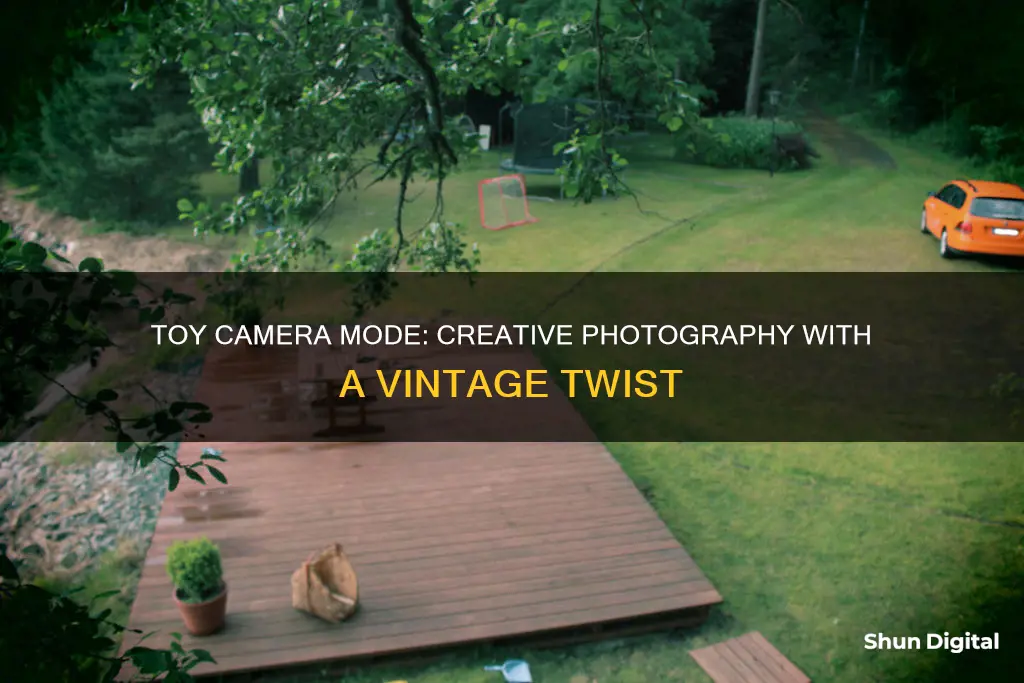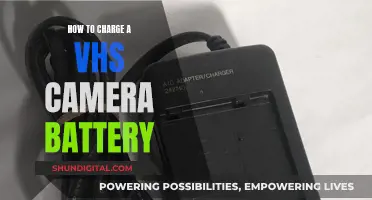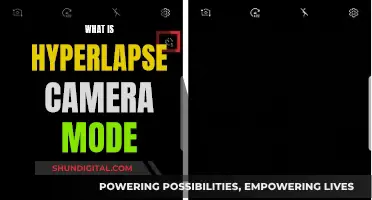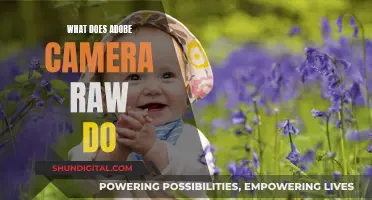
Toy Camera mode is a creative shooting mode that enables photographers to take pictures that mimic the aesthetic of images shot with a toy camera. Toy cameras are simple, inexpensive film cameras made predominantly of plastic and paired with a simplistic lens. They are usually made in China or the former Soviet Union. The Diana, LOMO and Holga are typically the cameras most associated with the term. Toy cameras are known for their vignetting, blurry focus, light leaks, and other distortions, which photographers exploit for artistic effect. Toy Camera mode allows photographers to achieve similar effects with their digital images, adding a unique retro feel to their photographs.
| Characteristics | Values |
|---|---|
| Purpose | To take pictures that look as if they were shot with a toy camera |
| Image Quality | Less technically perfect, with imperfections such as overlapping frames, light leaks, or lens distortions |
| Image Format | Square format |
| Focus | Fixed, blurred at the four corners |
| Colour | Flashy colours, or soft hazy image |
| Exposure | Well-balanced exposure to avoid an overexposed or underexposed image |
| Shutter Speed | Slower shutter speeds may show motion blur |
| Aperture | Smaller aperture increases the area of the image in focus |
| Film Speed | ISO 400 is commonly used in daylight |
What You'll Learn
- Toy cameras are simple, inexpensive, and fully functional
- They are predominantly made of plastic, including the lens
- Toy cameras are usually made in China or the former Soviet Union
- They are known for their vignetting, blur, and light leaks
- Toy camera mode in digital photography can replicate the effects of a toy camera

Toy cameras are simple, inexpensive, and fully functional
The appeal of toy cameras lies in their ability to create unpredictable and unique images. Photographers embrace the light leaks, blurry focus, and lens distortions as they add a sense of serendipity to the photographic process. By relinquishing control over the definitive outcome of the image, photographers can explore their creativity and experiment with different effects. This has led to the artistic use of toy cameras, with many professional photographers exploiting their quirks to capture award-winning pictures.
Toy cameras are typically easy to use and are often child's play, as the name suggests. However, having some basic knowledge of photography can help photographers get the best results. Understanding concepts like exposure, shutter speed, aperture, and film/sensor speed can enhance the images captured by these simple cameras. Most toy cameras have fixed shutter speeds and apertures, making them suitable for daylight shooting or low-light conditions with the use of a flash.
The shutter speed controls the amount of time the film or sensor is exposed to light, affecting the sharpness of the image. A slower shutter speed may result in motion blur, while a faster shutter speed helps to avoid it. Toy cameras usually have shutter speeds just fast enough to prevent motion blur, but excessive movement can still cause blurriness. Aperture, on the other hand, controls the amount of light that reaches the film or sensor and affects the sharpness of the image. A smaller aperture results in a greater area of the image being in focus but requires a longer shutter speed.
Film speed is another important consideration when using a toy camera. Faster films are more sensitive to light and collect it more quickly. The sensitivity of the film is measured in ISO numbers, with higher ISO values indicating greater sensitivity. Choosing the right film speed allows photographers to have some control over the exposure, especially since most toy cameras do not allow adjustments to shutter speed or aperture.
In summary, toy cameras offer a fun and creative way to capture images with a unique retro feel. Their simplicity, low cost, and functional capabilities make them an appealing option for photographers who want to explore beyond the technically perfect images produced by more advanced cameras. Embracing the quirks and imperfections of toy cameras can lead to artistic and award-winning photographs, as demonstrated by their widespread use and exhibition in the art world.
Fujifilm Camera: Converting RAW to JPEG Simplified
You may want to see also

They are predominantly made of plastic, including the lens
Toy cameras are predominantly made of plastic, including the lens. This cheap plastic design is what gives them their characteristic quirks and imperfections, such as overlapping frames, light leaks, and lens distortions. The plastic lenses are often simplistic in design, with vignetting, blurry focus, and lens distortion. The plastic construction of the camera body also allows light to leak into the film chamber, creating whimsical fields of colour that add character to photographs.
Toy cameras are typically inexpensive film cameras, with a simple design and construction. They first gained popularity in the 1990s for their distinctive aesthetic and unpredictable results. Despite their limitations, toy cameras offer photographers a unique and creative way to capture images, embracing imperfections and adding a sense of serendipity to the photographic process.
The plastic construction of toy cameras contributes to their low cost and accessibility. They are often designed to be used by children, with simple controls and fixed shutter speeds and apertures. This makes them ideal for shooting in daylight conditions, as they may not have a flash. However, some models do include a flash, allowing for low-light photography within the flash's range.
While toy cameras may have plastic lenses, some models offer adjustable features such as shutter speed and aperture settings. These adjustments can be used to control the exposure and focus of the image, allowing for some creativity and experimentation. However, the plastic construction of the lens and camera body can still introduce distortions and quirks that are beyond the photographer's control.
In summary, the plastic construction of toy cameras, including the lens, is a defining characteristic that sets them apart from more expensive and technically advanced cameras. The use of plastic contributes to their affordability, simplicity, and unique aesthetic, making them a fun and creative tool for photographers who embrace imperfection and unpredictability in their work.
Unlocking Note 9 Camera Modes: A Step-by-Step Guide
You may want to see also

Toy cameras are usually made in China or the former Soviet Union
Toy cameras gained popularity in the 1990s for their distinctive aesthetic, with photographers embracing the light leaks, blurriness, and lens distortions that add a sense of serendipity to the photographic process. The Lomographic Society, a commercial company selling analogue cameras, films, and accessories, specialises in cameras that may be considered toys, with "lo-fi" optics that produce whimsical effects. The company began by selling Soviet-era LOMO models, named after the Leningradskoye Optiko-Mekhanicheskoye Obyedinenie (LOMO). These cameras were produced by the formerly state-run optics manufacturer, LOMO PLC of Saint Petersburg, Russia, which created the 35mm LOMO LC-A Compact Automat camera.
The Lomographic Society has since moved on to produce its own range of analogue cameras, films, and accessories, including the Daguerreotype Achromat lens collection, inspired by 19th-century photography. They have also released products catered to digital devices, such as the Smartphone Film Scanner. The company continues to promote the Lomographic style, which involves taking spontaneous photographs with minimal attention to technical details, instead emphasising the unpredictable, non-standard optical traits of toy cameras and film processing techniques for artistic effects.
The Lomographic Society has a strong social presence, organising local and international events to promote the Lomographic style. Their products are not necessary to take Lomographic photos, but they have become known for their plastic "toy" cameras with questionable pricing, ranging from $100 to $400 USD.
Photolab 3: Compatible Camera Raw Files
You may want to see also

They are known for their vignetting, blur, and light leaks
Toy cameras are known for their vignetting, blur, and light leaks. These characteristics are embraced by photographers for the unpredictable and distinctive aesthetic they bring to images.
Vignetting is a common effect in toy camera images, where the corners of the image appear darker than the centre, drawing the viewer's attention inwards. This is caused by the lens not covering the total film base, resulting in uneven light exposure across the image. Vignetting can be adjusted in toy camera mode or simulated in post-processing software like Photoshop by applying a dark vignette around the edges of the image.
Blurry focus and lens distortion are also signature traits of toy cameras. The simplistic design of the camera and lens leads to images with a soft, hazy look and colour distortions. The limited control over shutter speed and aperture settings in toy cameras can result in motion blur, further contributing to the blurry effect.
Light leaks are another distinctive feature of toy cameras, caused by holes or gaps in the camera body that allow light to "leak" into the film chamber. This creates whimsical fields of colour that add character and a sense of serendipity to the photographic process. While light leaks can be considered a flaw by some photographers, others embrace them as a way to enhance their images with a touch of nostalgia and unpredictability.
The combination of vignetting, blur, and light leaks gives toy camera images a unique retro or vintage feel that is cherished by many photographers. By embracing these quirks, photographers can add a creative and artistic touch to their images, toying with their creativity and having fun in the process.
Exploring the Creative Power of Camera Raw's Effects Tab
You may want to see also

Toy camera mode in digital photography can replicate the effects of a toy camera
Toy camera mode in digital photography can replicate the effects of shooting with a toy camera. Toy cameras, which are usually made of plastic, produce images with a distinctive aesthetic due to their simplistic lenses and light leaks. The resulting images have a retro feel, with vignetting, blurry focus, and lens distortion.
Digital cameras often have a creative shooting mode that includes a toy camera mode. This mode allows photographers to replicate the effects of a toy camera while maintaining some control over the image. In toy camera mode, photographers can adjust the vignetting, brightness, colour saturation, and focus to achieve the desired effect.
To replicate the square format of toy camera images, photographers can crop their images accordingly. They can also add a vignette by duplicating the layer and adjusting the brightness at the corners to pull the viewer's attention to the centre of the image. Blurring certain parts of the image can also be done to mimic the blurry focus often seen in toy camera photographs.
Additionally, toy cameras often lend a distinctive colour cast to photographs, which can be emulated by adjusting the RGB channels in the Curves adjustment palette. Light leaks, another characteristic of toy cameras, can be recreated by adding patches of colour to the image using a new layer and a brush tool.
By using toy camera mode and applying various editing techniques, digital photographers can replicate the unique effects of shooting with a toy camera while maintaining some level of control over the final image.
Charging the Lytro Camera: A Step-by-Step Guide
You may want to see also
Frequently asked questions
Toy Camera mode is a setting on your digital camera that enables you to take pictures that look like they were shot with a toy camera.
Toy cameras are simple, inexpensive film cameras made predominantly of plastic and paired with a simplistic lens. They are usually made in China or the former Soviet Union.
Toy camera images often feature vignetting, blurry focus, light leaks, and other distortions.







